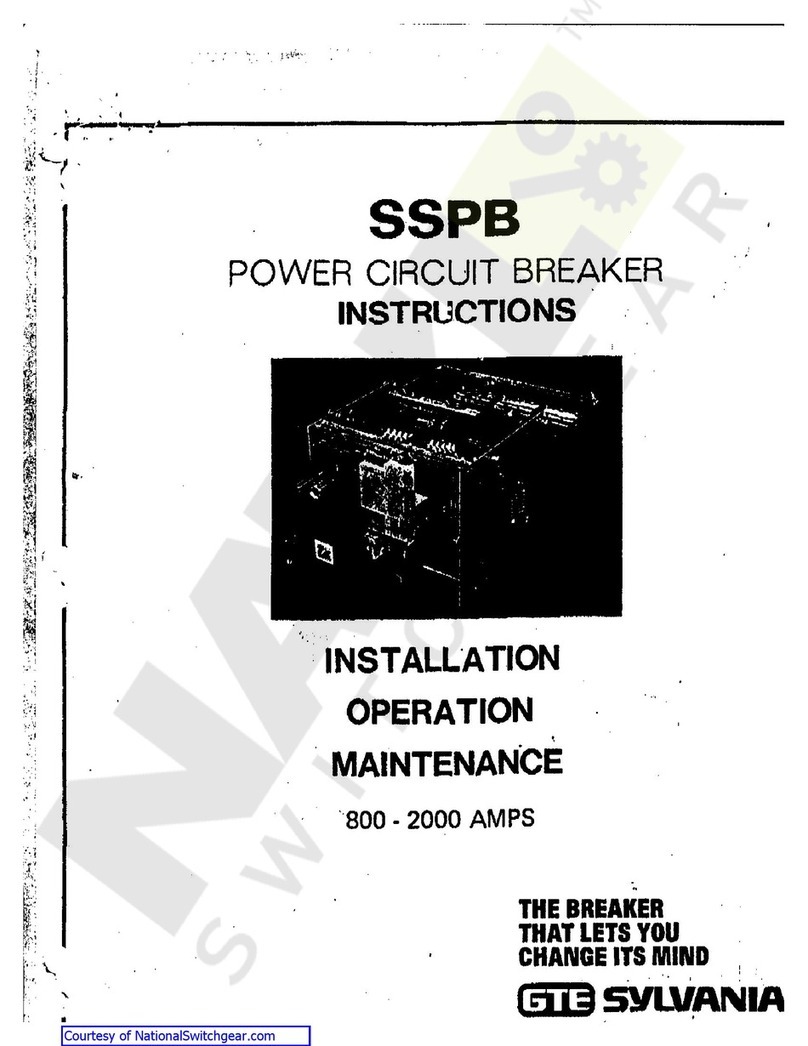
...
)
(.
· charged closing springs
cannot
be released.
Maintaining a remote tripping signal nullifies
any
remote
or
local closing action. It
is
possible
to
depress
the
local close
button
causing the closing
spring
to
release; however,
the
main contacts will
not
close until
the
remote tripping signal
is
re·
moved. Should it be desired
to
prevent accidental
closing when
the
local trip
button
is
released, an
undervoltage release device with lockout must
be
used for remote tripping.
Where electrically operated breakers equipped with
an undervoltage release are closed by a
constant
signal, there are
two
possible methods
of
operating,
depending upon
whether
the closing electro·
magnet and undervoltage release are energized by
the same source
or
separate sources.
Common Source: Voltage drops · breaker trips
Voltage restores · breaker
automatically closes
Separate Source: Voltage drops · breaker trips
Voltage restores · breaker re·
mains open
The closing signal
must
be momentarily removed
in
order
to
reclose
the
breaker.
If
a closing signal
is
maintained even when
the
closing spring
is
dis·
charged,
the
breaker will automatically close
at
the
completion
of
spring charging. This would
occur
where voltage
is
applied simultaneously
to
the
charging motor and closing electromagnet.
The
latch keeping
the
closing spring charged
cannot
be
released if the breaker
is
in
the
closed position.
5. Auxiliary Circuits (Cradle/Element)
The
SSPB
breaker can be equipped with a maxi-
mum of 24 secondary isolating contacts. Each
con·
tact
is
designed
to
accept
two
Y.."
quick disconnect
lugs
per terminal.
The secondary isolating blocks may contain up
to
twenty-four (24) terminals, twelve (12)
on
each
side, which may be used for breaker operation and
alarm circuits. Internal wiring
of
breakers
is
num·
bered
in
conformity with standard wiring diagrams.
The terminals
of
the
secondary
or
stationary iso·
lating contacts on
the
cradle are arranged and con-
nected
in
a manner
to
permit
interchangeability
of
similar elements.
Six terminals
of
the
secondary isolating block are
.3.
required
to
operate electrically operated breakers,'
Two
of these terminals are made
continuous
through
the
test-service position
in
order
to
pro-
vide power for
the
spring charging motor.
The
remaining four are for closing and tripping.
In
some applications, it may be necessary
to
e,lectrically connect
the
breaker
in
the
cradle
service position
differe~tly
from
that
in
the
test
position. This can be accomplished
by·
removing
the
test
or
service terminal. After
the
fixed second·
ary isolating
contact
block has been removed,
it
is
only necessary
to
remove
the
terminal
by
un·
screwing
the
fixing screw and breaking
the
bridge
between
the
test and service contacts
at
the
neck
provided for this purpose.
To
protect the auxiliary wires from physically
coming
in
contact
with moving parts when
the
breaker
is
being inserted
or
withdrawn, an enclosed
passage, located
at
the
point
of
exit from
the
stationary isolating terminal block,
is
provided.
6. Auxiliary Circuits (Devices)
Auxiliary contacts may be added
as
an accessory
either
on
electrically
or
manually operated
breakers. A built-in time differential
of
15 milli·
seconds
is
available between
contact
group posi-
tions
1-8
and 9-16 for sequence logic.
Contact
positions 9-16 act simultaneously with main
contacts.
7. Arrangement
of
Cubicle Door
The cubicle door for
drawout
air circuit breaker
elements
is
provided with
·&n
opening permitting
entry
of the control board
or
front
escutcheon
plate. A retracting collar surrounding
the
escutch·
eon plate permits the operator
to
rack the breaker
element from the service position
to
the test
or
fully open position without opening the cubicle
door. It
is,
therefore, possible
to
store breakers
without
fear
of
unauthorized personnel having
access to them.
8.
Static Sensors
Static
sensors consists
of
separate printed circuits
for
long time, short time, instantaneous,
and
ground fault tripping. Components are pre-aged
and
factory calibrated
to
insure utmost tripping
accuracy.
No
field calibration
is
required. Since
cards have been designed
for
plug-in field installa·
tion,
it
Is
possible
to
change systems by simply
"··
f
Courtesy of NationalSwitchgear.com




























